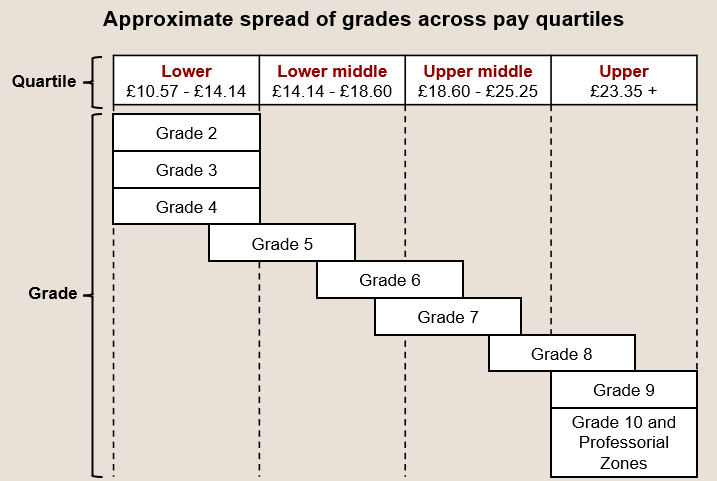Pay gaps at the University of Leeds

As a large employer, the University must annually report its gender pay gap. The University also chooses to go beyond legal requirements and to publish its ethnicity and disability pay gaps, as part of a commitment to good Equity, Diversity and Inclusion (EDI) practice.
On this page, you can find information about pay gaps, why they exist and most importantly – what the University is doing to address them.
What are pay gaps?

Pay gaps are the percentage difference between the average hourly rates of pay for different groups. For example, if the average hourly pay for women in an organisation was £13 and for men was £15, then the difference would be £2, a 13% gender pay gap.
Both the mean (from the average) and median (from the middle value) pay gaps are calculated. Mean pay gaps tend to be higher as they’re influenced by extremes, such as a smaller number of people with very large salaries.
Pay gaps are different to equal pay. Equal pay is legislation that stipulates men and women in the same employment performing equal work must receive equal pay. Pay gaps look at average pay across an organisation.
The University’s pay gaps

Gender pay gap
In 2024, the mean gender pay gap at the University was 17.1%, down from 18.2% in 2023. This is the lowest mean pay gap since the University started reporting in 2017 when the mean gender pay gap was 22.5%. The 2024 median gender pay gap was 13.4%, down from 15.4% in 2023.
The University’s gender pay gap is consistent with the Russell Group average (mean: 17.3%, median: 13.0%), but above sector averages (mean: 14.8%, median: 12.3%, UCEA analysis 2024).
Ethnicity pay gap
The ethnicity pay gap is the percentage difference between the average hourly rates of pay for Black, Asian and minoritised ethnic staff, and white staff.
In 2024, the mean ethnicity pay gap at the University was 10.5%. The mean ethnicity pay gap has been around 10% since reporting began in 2021. The 2024 median ethnicity pay gap was 6.3%, up from 4.9% in 2023.
The University’s ethnicity pay gap is above the Russell Group average (mean: 7.3%, median: 5.3%), and sector averages (mean: 4.7%, median: 2.6%, UCEA analysis 2023).
Disability pay gap
The disability pay gap is the percentage difference between the average hourly rates of pay for disabled staff and non-disabled staff.
In 2024, the mean disability pay gap at the University was 8.9%, an increase from 8.0% in 2023. The 2024 median disability pay gap was 7.1%, which has also increased from 5.6% in 2023.
The University’s disability pay gap is consistent with the sector mean of 8.5% and below the sector median of 9.6% (Advance HE Staff Statistical Report 2024).
Explore the data
In the following graphs, you can see hourly pay and the University pay gaps by year. The filters allow you to swap between characteristics and the mean/median pay gaps. Hover over the graph lines and bars for more information.
Why do pay gaps exist?

Pay gaps exist because of the unequal distribution of women, minoritised ethnic and disabled staff across grades.
For example, in 2024, 67% of professors in the University were men. This increases the average male hourly rate (as professors are the highest paid staff in the University) and so contributes to the gender pay gap.
Analysing pay distribution
To look at pay distribution, staff are divided into four equal sized groups – or quartiles – based on their hourly pay. This shows which groups make up the lowest, two middle and highest paid quartiles of the University.
The following graphic shows the 2024 pay quartiles, and the approximate spread of grades across each quartile:
The lower quartile represents staff earning between £10.57 and £14.14 per hour, and covers approximately grades 2 to 4, and a small portion of grade 5.
The lower middle quartile represents staff earning between £14.14 and £18.60 per hour, and covers the majority of grades 5, 6 and a small portion of grade 7.
The upper middle quartile represents staff earning between £18.60 and £25.25 per hour, and covers most of grade 7 and nearly half of grade 8.
The upper quartile represents staff earning over £25.35 per hour, and covers just over half of grade 8, and all of grades 9, 10 and the Professorial Zones.
Analysing pay quartiles helps explain why pay gaps exist and supports the identification of evidence-based actions/initiatives to tackle them.
Pay distribution by gender
The data shows that women are overrepresented in lower paid roles – 66.5% of the lower quartile are women (this is approximately grades 2 to 4 on the University pay scales).
In contrast, women are underrepresented in higher paid roles – 43.2% of the upper quartile are women (approximately grades 8 to Professor).
In 2024, of the highest earners at the University (salary over £100,000), 31% were women.
Pay distribution by ethnicity
There are roughly equal proportions of minoritised ethnic staff across quartiles which makes the ethnicity pay gap smaller than the gender pay gap – but the proportion of staff who have not recorded their ethnicity make analysis less reliable.
The proportion of minoritised ethnic staff decreases from 13% in the Professorial Zone 1 (lowest paid professors) to 7% in Professorial Zone 3 (highest paid professors).
In 2024, of the highest earners at the University (salary over £100,000), 8% were minoritised ethnic staff.
Pay distribution by disability
The proportion of staff who have not recorded whether they’re disabled makes disability pay gap analysis less reliable.
Between 2023 and 2024, there has been an increase in the proportion of disabled staff across all quartiles. +0.7% in the lower quartile, +0.9% in the lower middle quartile, +0.4% in the upper middle quartile and +0.9% in the upper quartile.
In 2024, of the highest earners at the University (salary over £100,000), 3% were disabled.
Explore the data
In the following graph, you can explore the pay quartiles and grade distribution of the University by gender, ethnicity and disability.
Bonus gaps

In addition to pay gaps, the University is required to publish its bonus gaps – the difference between the average bonus amounts received by different groups of staff. Disability bonus gaps are not calculated as the sample size is too small to produce reliable data.
The University of Leeds offers discretionary bonuses but not contractual ones. These include one-off payments (for outstanding contributions), reward vouchers from the University Recognition Scheme and Clinical Impact Awards.
Clinical Impact Awards (CIAs) are mandated, decided upon and funded by the NHS, and given to outstanding clinical staff. CIAs significantly skew the University’s overall bonus gaps as the amounts awarded can be much higher than the University’s typical bonuses.
Men are more likely to be awarded – in 2024, 54 men and 17 women were awarded CIAs.
Gender bonus gap
In 2024, 13.1% of female staff received a bonus, compared to 12.3% of male staff.
The mean gender bonus gap including CIAs was 75.9% and excluding CEAs was 3.2%. The median gender bonus gap (including and excluding CIAs) was 0%.
Ethnicity bonus gap
In 2024, 9.4% of minoritised ethnic staff received a bonus compared with 17.6% of white staff.
The mean ethnicity bonus gap including CIAs was 40.8% and excluding CEAs was -14.1%. The median ethnicity bonus gap including and excluding CIAs was 0%.
Explore the data
In the following graph, you can explore the University’s gender and ethnicity bonus gaps over the years.
What is the University doing about pay gaps?

The EDI Strategy and Implementation Plan
The EDI strategy, underpinned and supported by the EDI Implementation Plan (PDF), aims to tackle many of the underlying structural inequalities that produce pay gaps. They focus on addressing underrepresentation through positive action and other EDI interventions.
Athena Swan
Over the next two years, the University will be re-applying for its institutional Athena Swan award. This will include a self-assessment of gender equality within the University and subsequent action plan to address the barriers across the employee lifecycle for women.
Faculty Athena Swan submissions and activities continue to drive change on a local level within faculties and schools.
Race Equality Charter
The University is currently undertaking a race equality self-assessment to apply to the Race Equality Charter. This process is identifying the barriers experienced by minoritised ethnic staff, and the action plan produced will aim to address many of the structural issues which produce the ethnicity pay gap.
Support for disabled staff
The University is currently implementing several University Executive Group (UEG) endorsed recommendations to improve the effectiveness of support for disabled staff at the University. This includes piloting a new reasonable adjustments process, reviewing adjustments funding and developing the provision of disability awareness training.
Career pathways review
The Career Pathways programme led by People and Culture will improve routes for progression for both academic and professional services staff. It will create clarity and consistency in progression routes and help the University understand and support key career transition points. The programme has a focus on improving the representation of women, Minoritised ethnic and disabled colleagues.
Improving data
In 2025 the Equality and Inclusion Unit, in collaboration with relevant stakeholders, will develop a long-term EDI data quality plan with targets, an informed approach and planned activity. The Corporate Processes and Systems (CPS) programme and the implementation of the new HR system and new HR processes will be critical in increasing confidence in analysis and assumptions about pay and bonus gaps.
About the data

The University is required to include all employees and casual workers in its calculations (referred to as ‘staff’ on this page). Casual workers are engaged by the University to support educational activity and short-term temporary assignments.
The data used in the calculations counts all staff on 31 March each year.
Within gender data, non-binary staff are removed from analysis. The small sample size for this group makes analysis unreliable.
In the ethnicity and disability data, there is a field titled ‘Unknown staff’ – this includes staff who have not recorded their ethnicity or whether they are disabled. Many of these staff are casual workers.
Having large numbers of ‘Unknown staff’ in the data makes it less reliable and means drawn conclusions are less certain. In the coming year, the University will be working to increase completion rates as set out in the EDI Implementation Plan.
